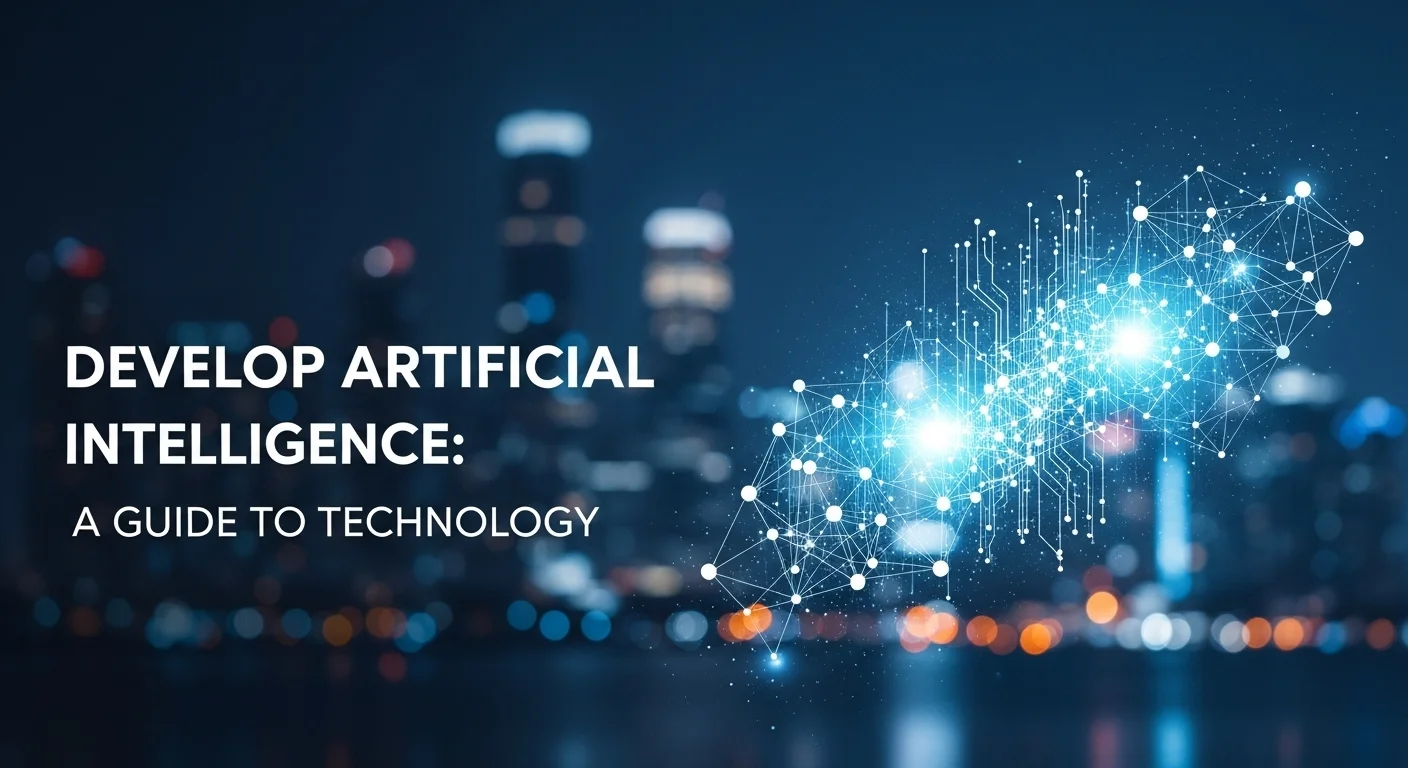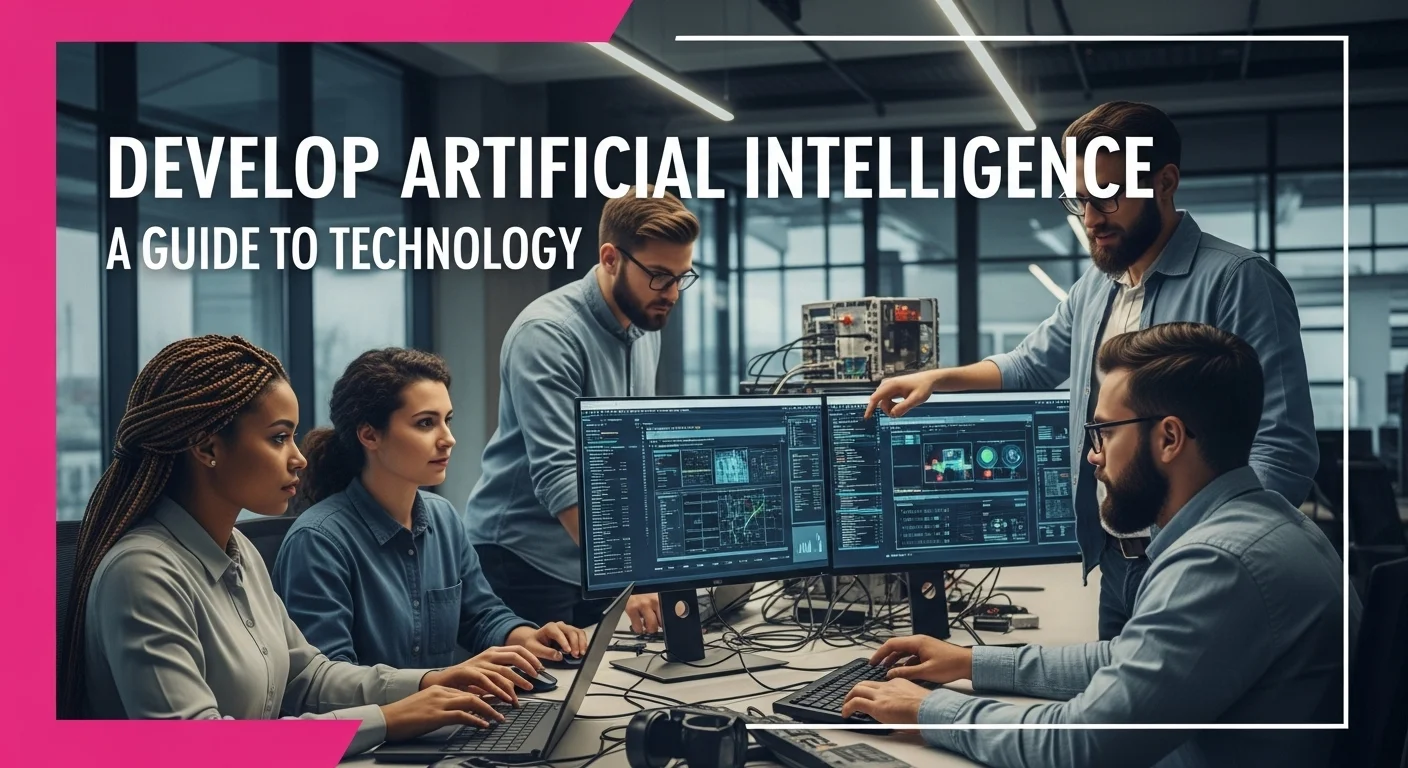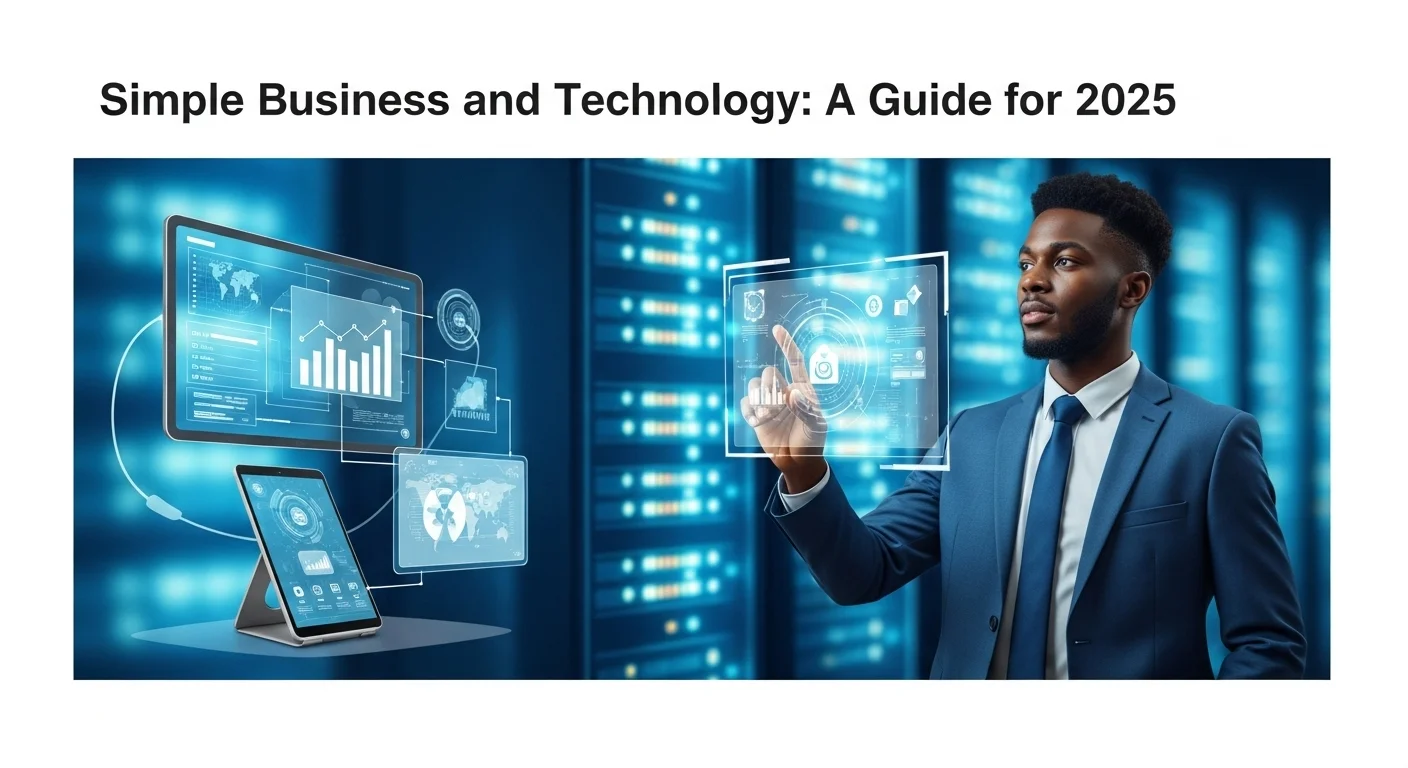A Practical Guide to Developing Artificial Intelligence for Your Business

Executive Summary
This guide is your starting point for understanding how to develop artificial intelligence. I've spent years helping businesses navigate this world, and I've seen how AI can transform an organization. We'll cut through the jargon to explore what AI really is, why it’s a game-changer for business growth, and the strategies that leading AI development firms use to build incredible solutions. We'll look at how AI is becoming a core part of business strategy, not just a tech tool. You'll get a clear picture of how specialized firms, including those focused on mobile apps, make AI accessible. For any leader looking to innovate, understanding the AI landscape is no longer optional. Think of this as your personal roadmap to leveraging AI for real-world results and staying ahead of the curve.
Table of Contents
What is Artificial Intelligence and Why is it Important?
When we talk about developing artificial intelligence (AI), we're really talking about creating systems and software that can perform tasks that normally require human smarts. This includes things like learning from experience, solving problems, understanding conversations, and even 'seeing' the world through computer vision. Over my career, I've seen AI evolve from a niche academic field into a foundational technology that's reshaping entire industries. It's not just another small upgrade; it's a massive shift. AI automates the complex, finds hidden gems of insight in mountains of data, and creates capabilities we once only dreamed of. For any business today, using AI for growth isn't a futuristic idea—it's a practical necessity for staying competitive.
The real magic of AI lies in its ability to analyze enormous datasets faster and more accurately than any human ever could. In our age of 'big data,' this is critical. AI is the engine that powers the personalized experiences we've come to expect, from Netflix recommendations to customized healthcare advice. It optimizes supply chains, makes our cities smarter, and helps scientists discover new medicines. We interact with AI all the time without even realizing it, from the spam filters in our inbox to the GPS on our phones. Its importance is woven into the fabric of our digital lives.
The Role of Specialized AI Development Firms
Let's be honest: building powerful AI is complex and expensive. It takes specialized knowledge, a ton of computing power, and a team of very smart people. This is why a whole industry of specialized AI development firms has emerged. These companies are the architects building the AI-powered future. They partner with businesses in every sector—finance, healthcare, retail—to create custom AI solutions for specific challenges. For many organizations I've worked with, partnering with one of these firms is the fastest and most effective way to get into the AI game without the massive upfront cost of building a team from scratch. These aren't just vendors; they're strategic partners who guide you from the initial idea to a fully functioning system.
A particularly exciting corner of this world is the AI mobile app development company. With smartphones being our primary window to the digital world, packing AI features into apps is crucial for a great user experience. These specialists are masters at making complex AI models run smoothly on our phones, without draining the battery. They’re behind the real-time translation, smart photo editing, and helpful virtual assistants we now take for granted. Their work is a perfect example of how AI is becoming more accessible, putting incredible power right into our hands and changing how we interact with technology every single day.
Artificial Intelligence in Business Development: A Paradigm Shift
The conversation I have with leaders about AI has shifted dramatically. It's no longer just a technical chat; it's a core strategic discussion. Using AI for business development means rethinking how you find customers, operate, and grow. AI tools can pinpoint the best sales leads, forecast market trends, and create personalized marketing campaigns that truly connect. For instance, an AI-enhanced CRM can analyze emails and calls to suggest the perfect next step for a salesperson, significantly boosting their chances of success. It allows a business to be predictive and proactive, not just reactive.
The bottom line is that AI gives you a serious competitive edge. Companies that embrace AI can operate more efficiently, make smarter decisions, and deliver better products. By automating routine tasks, you free up your team to focus on creative, high-value work. By using predictive analytics, you can spot potential problems, from equipment failure to fraud, before they become disasters. In my experience, the gap between companies that use AI and those that don't is widening fast. Understanding how to partner with AI development firms and build a strategy around AI for business growth is the cornerstone of success in our increasingly intelligent world.

A Complete Guide to AI Development for Business Solutions
Developing artificial intelligence isn't about waving a magic wand; it's a structured journey that turns a business problem into a working, data-driven solution. This is where the rubber meets the road. The process always starts with a simple, non-technical question: What problem are we trying to solve? Defining this clearly is the most critical first step. It ensures that the final AI tool actually provides real value, which is the whole point of using AI for business growth.
The AI Development Lifecycle: A Step-by-Step Approach
- Data Sourcing and Preparation: I always say that AI is hungry for data, but it's a picky eater. This phase is all about gathering and cleaning the data needed to train your model. This is often the most time-consuming part of any project, because the quality of your AI depends entirely on the quality of your data. Raw data needs to be cleaned up, formatted consistently, and engineered to highlight the most important information for the model.
- Model Selection and Training: With clean data in hand, you choose the right machine learning model for the job. Is it predicting a price? That's a regression model. Is it sorting customers into categories? That's a classification model. The chosen model is then 'trained' on the data, where it learns to find patterns and make predictions. This requires a lot of computing power, which is why cloud platforms are so popular.
- Model Evaluation and Tuning: After training, we have to test the model on data it's never seen before. This is crucial to make sure it can handle real-world situations and wasn't just 'memorizing' the training data. We use various metrics to score its performance and then fine-tune its settings to make it even better. It’s an iterative cycle of test, refine, repeat.
- Deployment and Integration: A great model sitting on a data scientist's laptop is useless. Deployment is the process of putting the AI to work in your actual business environment, whether it's through an API or embedded directly in your app. An AI mobile app development company, for instance, has deep expertise in making this happen efficiently on smartphones.
- Monitoring and Maintenance: The world changes, and so does data. An AI model can become less accurate over time—a phenomenon called 'model drift.' It's essential to monitor its performance constantly and retrain it with fresh data to keep it sharp and relevant. This ongoing care ensures you get long-term value from your investment.
Technical Methods and Resources
The toolbox for AI development is always growing, but Python is the undisputed king. It’s supported by powerful libraries that do a lot of the heavy lifting:
- TensorFlow and PyTorch: These are the two industry-leading frameworks for building the complex 'neural networks' behind deep learning.
- Scikit-learn: The go-to library for classic machine learning tasks like classification, regression, and clustering.
- Cloud Platforms: Services like AWS, Azure, and Google Cloud are essential. They provide the infrastructure for everything from data storage to model deployment, allowing even smaller AI development firms to compete with the giants.
Building vs. Buying: A Strategic Decision
This is a question I get all the time: should we build our own AI team or hire an external partner? Building an in-house team gives you total control, but finding and retaining top AI talent is incredibly difficult and expensive. For most businesses, partnering with an established AI development company is the more practical route. They bring immediate expertise, proven methods, and a wealth of experience, which dramatically speeds up the process and reduces risk. This decision is fundamental to your AI strategy, balancing long-term goals with the need for immediate results.

Tips and Strategies for AI Development
Getting started with artificial intelligence can feel overwhelming, but I promise that with the right strategy, it's entirely manageable. The key is to move past the hype and focus on creating practical solutions that deliver real value. Turning the complex process of AI development into a successful project is all about having a smart plan and following best practices.
Best Practices for AI Implementation
- Start with a Clear Business Problem: I can't stress this enough. The biggest mistake I see is companies falling in love with the technology before identifying a problem. Start with a real-world headache you want to solve. Is it reducing customer complaints? Optimizing your inventory? Automating a tedious manual process? A clear goal makes everything else fall into place.
- Prioritize Data Quality and Governance: Your AI is only as smart as the data you feed it. Before you write a single line of code, make sure your data is clean, accurate, and relevant. Good data governance is also essential to handle privacy and security properly. Top-tier AI development firms spend more than half their time on this step for a reason.
- Embrace an Iterative, Agile Approach: Don't try to build the perfect, all-knowing AI system on day one. Start small with a 'proof-of-concept' to prove the idea works and show some quick wins. This agile approach lets you learn and adapt as you go, reducing risk and building momentum.
- Foster Collaboration Between Tech and Business Teams: AI is a team sport. Success depends on your tech experts and your business experts working together closely. Business folks provide the crucial industry knowledge, and the tech team provides the horsepower. This synergy is what makes AI for business development truly effective.
- Plan for a Human in the Loop (HITL): In many critical areas like healthcare or finance, a fully autonomous AI isn't the goal. A 'Human-in-the-Loop' system is often better, where AI does the heavy lifting and a human expert handles tricky cases or gives final approval. This builds trust and ensures accountability.
Essential Business Tools and Resources
The ecosystem of AI tools is exploding, with many 'low-code' or 'no-code' options making the tech more accessible. Key tools to know include:
- AI-Powered CRM Platforms: Tools like Salesforce Einstein and HubSpot use AI to analyze customer data, predict sales, and personalize outreach.
- Marketing Automation Tools: Platforms such as Marketo leverage AI to optimize email campaigns and create personalized website experiences.
- Business Intelligence (BI) Tools: Tableau and Microsoft Power BI are embedding AI features that let you ask questions in plain English to uncover hidden insights in your data.
- Specialized Service Providers: For complex projects, you'll want to partner with an expert. This could be a broad AI development firm or a specialist, like an AI mobile app development company for mobile-first initiatives.
Ethical Considerations and Future-Proofing
As you develop AI, you must address the ethical side. This means actively working to prevent bias in your data, being transparent about how your AI makes decisions (a field called Explainable AI), and being responsible for the outcomes. I've learned that building an ethical framework isn't just about compliance; it's about earning long-term trust with your customers. For a great deep dive into this, the Gartner AI research hub is an excellent resource.
Finally, AI is moving at lightning speed. To keep up, foster a culture of continuous learning. By combining a solid strategy, technical excellence, and ethical responsibility, you can build AI solutions that not only work but also create a lasting competitive advantage for your business.
Expert Reviews & Testimonials
Sarah Johnson, Business Owner ⭐⭐⭐⭐
Good foundational article. As a small business owner, I was hoping for more specific case studies for companies my size, but it definitely clarified the basics of AI development for me.
Mike Chen, IT Consultant ⭐⭐⭐⭐⭐
As an IT consultant, I found this to be a really solid overview of the AI development process. It connects the technical steps to business strategy well, which is helpful for explaining it to my clients.
Emma Davis, Tech Expert ⭐⭐⭐⭐⭐
Fantastic and comprehensive guide to AI development. It covers the full lifecycle clearly and the section on ethics is especially important. A must-read for anyone in the tech space.



